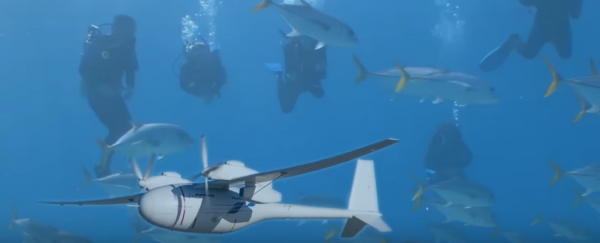Boeing's latest patent application is yet more evidence of just how rapidly drone technology is advancing: it shows an Unmanned Aerial Vehicle (UAV) that can, at a moment's notice, swoop down into the depths of the ocean and continue its journey underwater. The official name for this futuristic bit of equipment is a "rapid deployment air and water vehicle".
As you might expect, it's ultimately intended for military use. The drone is theoretically launched from an aircraft carrier, and once it decides the time has come to hit the water, portions of the wings are detached and abandoned to reduce drag. The drone can then continue on its exploratory mission before resurfacing to report back to base.
Like any patent filing, this is only an indication of the way Boeing is thinking and the direction some of its research is going in. We don't yet know if the company actually wants to build one of these versatile drones or if we'll ever see one in action, but it's an intriguing concept that opens up some interesting possibilities for drone-powered transport and research in the future.
Once under the water, a buoyancy tank helps keep the craft moving along its route, and a second set of propellers are engaged. Boeing doesn't specify any extra details about its planned drone, so we don't know what materials it's using or the motor running inside - the company has been working on Unmanned Underwater Vehicles (UUVs) for close to 10 years now though, so its engineers obviously know all about the factors involved.
As Boeing notes in its patent applications, UAVs and UUVs of this sort are typically dispatched in situations where it's too expensive or too dangerous to send a human being. Provided they're kitted out with enough cameras and sensory equipment, they can act as eyes and ears to the human operators back at base, which may be thousands of kilometres away. Boeing also has commercial viability in mind, because building a drone that can cope with both air and water is ultimately cheaper than building one for each scenario.
This is by no means the first time engineers have tried to come up with a transforming aircraft/submarine hybrid, as Gizmodo points out. The Soviet Union attempted to build a flying submarine during World War II, for example, but couldn't get a working design off the ground. The Reid Flying Submarine from 1962 is the closest anyone has ever got, but it didn't perform well in either the air or the water, impressive though the mechanics were.
